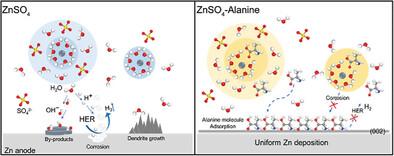Multifunctional Amphoteric Additive Alanine Enables High-Performance Wide-pH Zn Metal Anodes
IF 13
2区 材料科学
Q1 CHEMISTRY, MULTIDISCIPLINARY
引用次数: 0
Abstract
Interfacial pH fluctuation is one of the primary reasons for issues related to Zn metal anodes. Herein, polar amphoteric alanine, as a multifunctional electrolyte additive, is designed to regulate the electric double layer (EDL) and solvation structure. Alanine with self-adaptation capability to pH can stabilize electrolyte pH. Due to more negative adsorption energy, alanine preferentially adsorbs on the Zn surface and repels water molecules within the EDL. Alanine-enriched EDL effectively shields the surface tips, homogenizes interfacial electric field distribution, and promotes preferential deposition of horizontal flaky Zn. Alanine-enriched EDL limits the contact between water and the Zn anode. Alanine additive decreases the quantity of water molecules in the Zn2+ solvation sheath and disrupts H-bond networks in the electrolyte. Consequently, a dense and textured Zn deposition is achieved. Corrosion and side reactions are suppressed. Cycling stability of symmetrical cells attains 2700 h at 3 mA cm−2/1 mAh cm−2 and 2050 h at 5 mA cm−2/1 mAh cm−2. Average coulombic efficiency reaches 99.8% over 4500 cycles at 5 mA cm−2/1 mAh cm−2. Even within KOH alkaline electrolytes, alanine additive still improves the cycling lifespan of symmetrical cells to 100 h at 0.5 mA cm−2/0.5 mAh cm−2.

多功能两性添加剂丙氨酸实现高性能宽pH值锌金属阳极
界面 pH 值波动是造成锌金属阳极相关问题的主要原因之一。在此,极性两性丙氨酸作为一种多功能电解质添加剂,旨在调节电双层(EDL)和溶解结构。具有 pH 自适应能力的丙氨酸可以稳定电解质的 pH 值。由于丙氨酸具有更高的负吸附能,它能优先吸附在 Zn 表面,并排斥 EDL 中的水分子。富含丙氨酸的 EDL 能有效屏蔽表面尖端,均匀界面电场分布,促进水平片状 Zn 的优先沉积。富含丙氨酸的 EDL 限制了水与锌阳极之间的接触。丙氨酸添加剂会减少 Zn2+ 溶剂鞘中的水分子数量,并破坏电解质中的氢键网络。因此,可以实现致密、纹理清晰的锌沉积。腐蚀和副反应受到抑制。对称电池在 3 mA cm-2/1 mAh cm-2 条件下的循环稳定性达到 2700 小时,在 5 mA cm-2/1 mAh cm-2 条件下达到 2050 小时。在 5 mA cm-2/1 mAh cm-2 条件下循环 4500 次,平均库仑效率达到 99.8%。即使在 KOH 碱性电解质中,丙氨酸添加剂仍可将对称电池的循环寿命提高到 100 小时(0.5 mA cm-2/0.5 mAh cm-2)。
本文章由计算机程序翻译,如有差异,请以英文原文为准。
求助全文
约1分钟内获得全文
求助全文
来源期刊

Small
工程技术-材料科学:综合
CiteScore
17.70
自引率
3.80%
发文量
1830
审稿时长
2.1 months
期刊介绍:
Small serves as an exceptional platform for both experimental and theoretical studies in fundamental and applied interdisciplinary research at the nano- and microscale. The journal offers a compelling mix of peer-reviewed Research Articles, Reviews, Perspectives, and Comments.
With a remarkable 2022 Journal Impact Factor of 13.3 (Journal Citation Reports from Clarivate Analytics, 2023), Small remains among the top multidisciplinary journals, covering a wide range of topics at the interface of materials science, chemistry, physics, engineering, medicine, and biology.
Small's readership includes biochemists, biologists, biomedical scientists, chemists, engineers, information technologists, materials scientists, physicists, and theoreticians alike.
 求助内容:
求助内容: 应助结果提醒方式:
应助结果提醒方式:


